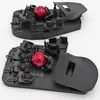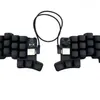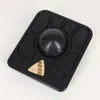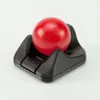Best Ergonomic Keyboards in 2025

Best Premium Split Keyboard: Svalboard
Keyboard with integrated trackball ($1k). Most ergonomic keyboard+mouse combination possible. Key motions minimized vs traditional boards. For medical-grade RSI or ultimate ergonomics.$1,000 on Svalboard
Best Value Split Keyboard: Totem
38 keys, contest winner with exceptional build quality. Splayed columns, 3-key wide thumb cluster, ZMK wireless. Premium aluminum option available. $150.$150 on AliExpress
Best Budget Split Keyboard: Cheapino v2
36 keys with excellent wide thumb cluster. Vial pre-configured, hotswap, single MCU design. Community: 'moved from Corne, thumb cluster so much more comfortable'. $70.$70 on AliExpressBest Trackball Mice in 2025

Best Premium Trackball Mouse: Svalboard
Keyboard with integrated trackball. Most ergonomic mouse AND keyboard possible. Medical-grade RSI solution with significant learning curve.$1,050 on Svalboard
Best Value Trackball Mouse: Ploopy Adept
Ambidextrous trackball with dynamic steel roller bearings (zero stiction), high polling rate. Perfect for switching hands to prevent RSI. Great for gaming.$75 on Ploopy
Best Budget Trackball Mouse: Ploopy Nano
Compact, budget-friendly trackball with dynamic bearings. Smaller ball but maintains Ploopy's quality standards with programmable firmware.$43 on PloopyScore | Brand | Model | Keys Total | Thumb Ergo Rating (1-10) | GUI Editor Tool | Availability Status | Firmware Type | Wireless Support | Price | Thumb Keys Per side | Tenting Option | Switches Type | Hotswap Support | Keywell Concave | Momentum Rating (1-10) | Rating | Col. Stagger Amount |
|---|---|---|---|---|---|---|---|---|---|---|---|---|---|---|---|---|---|
10.0 | 60 5 | 10.0 (integrated) 10 | Keybard ✓ 5 | Pre-built 5 | QMK / Vial 5 | No 6 | $1000 3 | 2 9 | Fully adjustable 5 | Custom 5 | No 5 | Yes 8 | 7.0 7 | 5 | None 3 | ||
8.5 | 38 9 | 9.0 (wide) 9 | ZMK Studio 8 | Pre-built 5 | ZMK 9 | Yes (2–3 months) 8 | $150 8 | 3 8 | Adjustable 5 | Choc 7 | Yes 8 | No 5 | 9.0 9 | 5 | Splayed 5 | ||
7.6 | 34 10 | 9.0 (wide) 9 | Vial ✓ 10 | Pre-built 5 | QMK / ZMK 5 | Yes (2–3 months) 8 | $85 10 | 2 9 | Optional 6 | MX/Choc 5 | Yes 8 | No 5 | 10.0 10 | 4.8 (120) 7 | Aggressive 9 | ||
7.5 | 34 10 | 9.0 (wide) 9 | ZMK Studio ✓ 10 | Pre-built 5 | ZMK 9 | Yes (2–3 months) 8 | $149 8 | 2 9 | Magnetic 5 | Choc 7 | Yes 8 | No 5 | 9.0 9 | 5 | Moderate 7 | ||
7.2 | 36 10 | 8.0 (wide) 8 | Vial ✓ 10 | Pre-built 5 | QMK 8 | No 6 | $70 10 | 3 8 | Kickstands 5 | MX 7 | Yes 8 | No 5 | 8.0 8 | 4.6 (85) 7 | Moderate 7 | ||
7.1 | 34 10 | 9.0 (wide) 9 | ZMK Studio 8 | Pre-built 5 | ZMK 9 | Yes (3–6 months) 8 | $75 10 | 2 9 | None 3 | Choc 7 | Yes 8 | No 5 | 7.0 7 | 5 | Aggressive 9 | ||
7.0 | 36 10 | 8.0 (moderate) 8 | Vial ✓ 10 | Pre-built 5 | QMK / Vial 5 | No 6 | $143 8 | 3 8 | None 3 | Choc 7 | Yes 8 | No 5 | 8.0 8 | 5 | Aggressive 9 | ||
7.0 | 36 10 | 7.0 (moderate) 7 | ZMK Studio ✓ 10 | Discontinued 2 | ZMK 9 | Yes (2–3 months) 8 | $380 4 | 3 8 | Built-in (15°) 6 | Choc 7 | Yes 8 | No 5 | 9.0 9 | 5 | Moderate 7 | ||
6.9 | 34 10 | 7.0 (standard) 7 | ZMK Studio 8 | DIY 5 | ZMK 9 | Yes (2–3 months) 8 | $120 8 | 2 9 | Puck mount 5 | Choc 7 | Yes 8 | No 5 | 7.0 7 | 5 | Moderate 7 | ||
6.8 | 36 10 | 8.0 (moderate) 8 | Vial ✓ 10 | Pre-built 5 | QMK / Vial 5 | No 6 | $98 10 | 3 8 | None 3 | MX/Choc 5 | Yes 8 | No 5 | 7.0 7 | 5 | Aggressive 9 | ||
6.8 | 36 10 | 8.0 (moderate) 8 | Vial ✓ 10 | Pre-built 5 | QMK / Vial 5 | No 6 | $98 10 | 3 8 | None 3 | Choc 7 | Yes 8 | No 5 | 7.0 7 | 5 | Moderate 7 | ||
6.7 | 80 3 | 7.0 (standard) 7 | Custom ✓ 6 | Pre-built 5 | ZMK 9 | Yes (1–2 months) 8 | $399 4 | 6 4 | Built-in (30°) 10 | Choc 7 | Yes 8 | Yes 8 | 8.0 8 | 4.7 (200) 7 | Aggressive 9 | ||
6.7 | 36 10 | 8.0 (moderate) 8 | ZMK Studio 8 | Limited 5 | ZMK 9 | Yes (2–3 months) 8 | $120 8 | 3 8 | None 3 | Choc 7 | Yes 8 | No 5 | 6.0 6 | 5 | Moderate 7 | ||
6.6 | 36 10 | 6.0 (narrow) 6 | Vial ✓ 10 | Pre-built 5 | QMK / Vial 5 | No 6 | $40 10 | 3 8 | None 3 | Choc 7 | Yes 8 | No 5 | 6.0 6 | 5 | Aggressive 9 | ||
6.6 | 36 10 | 9.0 (wide) 9 | VIA / ZMK ✓ 5 | Pre-built 5 | QMK / ZMK 5 | Yes (1–2 months) 8 | $95 10 | 3 8 | None 3 | MX/Choc 5 | Yes 8 | No 5 | 8.0 8 | 5 | Moderate 7 | ||
6.4 | 42 7 | 4.0 (cramped) 4 | Vial 9 | Pre-built 5 | QMK / Vial 5 | Yes (1–2 months) 8 | $100 10 | 3 8 | Optional 6 | MX/Choc 5 | Yes 8 | No 5 | 9.0 9 | 5 | Moderate 7 | ||
6.3 | 34 10 | 7.0 (narrow) 7 | ZMK Studio 8 | Discontinued 2 | ZMK 9 | Yes (2–3 months) 8 | $180 8 | 2 9 | None 3 | Choc 7 | No 5 | No 5 | 5.0 5 | 5 | Aggressive 9 | ||
6.0 | 74 3 | 7.0 (wide) 7 | SmartSet ✓ 5 | Pre-built 5 | ZMK 9 | Yes (2–3 months) 8 | $459 3 | 4 6 | Steep 5 | MX 7 | No 5 | Yes 8 | 7.0 7 | 5 | Aggressive 9 | ||
6.0 | 52 5 | 6.0 (narrow) 6 | Oryx ✓ 5 | Pre-built 5 | QMK 8 | No 6 | $365 4 | 2 9 | Limited 5 | Choc 7 | Yes 8 | No 5 | 8.0 8 | 5 | Moderate 7 | ||
5.9 | 36 10 | 7.0 (moderate) 7 | None 2 | Limited 5 | QMK 8 | No 6 | $120 8 | 3 8 | None 3 | Choc 7 | No 5 | No 5 | 6.0 6 | 5 | Moderate 7 | ||
5.9 | 72 3 | 6.0 (moderate) 6 | Oryx ✓ 5 | Pre-built 5 | QMK 8 | No 6 | $365 4 | 4 6 | Adjustable 5 | MX 7 | Yes 8 | No 5 | 8.0 8 | 5 | Aggressive 9 | ||
5.8 | 76 3 | 6.0 (moderate) 6 | Oryx ✓ 5 | Pre-built 5 | QMK 8 | No 6 | $270 6 | 3 8 | Adjustable 5 | MX 7 | Yes 8 | No 5 | 6.0 6 | 5 | Aggressive 9 | ||
5.6 | 65 5 | 4.0 (none) 4 | VIA 8 | Pre-built 5 | QMK 8 | Yes (1–2 months) 8 | $100 10 | 0 5 | None 3 | MX 7 | Yes 8 | No 5 | 5.0 5 | 5 | Minimal 5 | ||
5.5 | 80 3 | 6.0 (moderate) 6 | Bazecor ✓ 5 | Pre-built 5 | QMK 8 | Yes (2–3 months) 8 | $369 4 | 8 4 | Steep 5 | MX 7 | Yes 8 | No 5 | 7.0 7 | 5 | Moderate 7 | ||
5.4 | 34 10 | 6.0 (moderate) 6 | None 2 | DIY 5 | QMK / ZMK 5 | No 6 | $50 10 | 2 9 | None 3 | Choc 7 | No 5 | No 5 | 3.0 3 | 5 | Experimental 5 | ||
5.3 | 75 3 | 4.0 (none) 4 | VIA ✓ 8 | Pre-built 5 | QMK/VIA 5 | No 6 | $205 6 | 0 5 | None 3 | MX 7 | Yes 8 | No 5 | 7.0 7 | 5 | Minimal 5 | ||
4.9 | 70 5 | 3.0 (none) 3 | Basic 5 | Pre-built 5 | Proprietary 5 | Yes (1–2 months) 8 | $80 10 | 0 5 | None 3 | MX 7 | Yes 8 | No 5 | 4.0 4 | 5 | Minimal 5 | ||
4.9 | 87 3 | 4.0 (none) 4 | Onboard 5 | Limited 5 | Proprietary 5 | No 6 | $150 8 | 0 5 | None 3 | MX 7 | No 5 | No 5 | 5.0 5 | 5 | Minimal 5 |
Quick Compare
Keyboard Cheat Sheet
- Thumb ergonomics: THE most critical factor. Wide clusters with 2-3 keys prevent RSI. Cramped Corne-style clusters cause De Quervain's tenosynovitis.
- GUI Editor: Vial, VIA, or ZMK Studio eliminate firmware compilation hassle. Pre-flashed = plug-and-play.
- Key count: 34-36 keys is the sweet spot for minimalist splits. Enough keys without excessive hand movement.
- Firmware: QMK for wired (mature), ZMK for wireless (better battery). "Both" offers flexibility.
- Availability: In-stock from multiple vendors beats discontinued/DIY-only boards.
Why Split Keyboards?
Standard keyboards force your wrists into unnatural positions. When typing on a traditional keyboard, you squeeze your wrists inward (ulnar deviation) and pronate your forearms to reach the keys. This awkward positioning, sustained for hours daily, causes Repetitive Stress Injury (RSI) and Carpal Tunnel Syndrome (CTS).
Split keyboards solve this by allowing natural shoulder positioning—arms parallel, hands vertical, like holding a box. Combined with tenting (angling the keyboard halves), this eliminates wrist pronation and reduces strain on tendons and nerves.
Non-split "ergonomic" keyboards (like the Microsoft Sculpt or Logitech K860) are better than standard layouts but still force your hands into a shared space. True ergonomics require separation—allowing you to position each hand naturally without compromise.
Critical Features to Look For
1. Thumb Ergonomics (Most Important)
The thumb cluster makes or breaks ergonomics. Many keyboards (notably the popular Corne) use cramped thumb clusters that force your thumb to curl inward or stretch outward uncomfortably. Extended layer holds with these designs can cause De Quervain's tenosynovitis (thumb tendonitis).
What to look for:
- 2-3 thumb keys per side is optimal. More keys = more cramping.
- Wide spacing (19mm+) between thumb keys prevents "pinching inward" motion.
- Natural arc positioning following your thumb's range of motion, not forcing curls or stretches.
- Avoid Corne-style clusters where the innermost key sits under your palm requiring thumb curl.
Best thumb ergonomics: Cheapino v2, Waterfowl (wide arcs), Ferris Sweep, Totem (well-spaced). Our top picks all feature excellent thumb cluster design.
2. GUI Keymap Editor (Essential for Usability)
Split keyboards require custom keymaps—you'll be moving keys, creating layers, and setting up shortcuts. A GUI editor is the difference between plug-and-play productivity and hours of firmware compilation frustration.
Best options:
- Vial (QMK, wired): Real-time editing with no reflashing. Supports advanced features like per-key tap-hold timing, combos, macros, and tap dance. Changes apply instantly.
- VIA (QMK, wired): Simpler than Vial but still powerful. Great for basic remaps and layers.
- ZMK Studio (ZMK, wireless): Live remapping for wireless boards. Best when enabled out-of-box (add CONFIG_ZMK_STUDIO=y in prj.conf if compiling yourself).
Pre-flashed = plug-and-play. Look for keyboards that ship with Vial/VIA/ZMK Studio already configured. This eliminates the biggest barrier for newcomers.
3. Key Count: 34-36 is the Sweet Spot
Minimalist splits (34-36 keys) force good ergonomic habits—minimizing hand movement and relying on layers instead of reaching. This reduces strain while increasing efficiency once you adapt.
- 34 keys (2 thumb keys per side): Maximum minimalism. Eliminates the "innermost thumb curl" problem entirely. Requires comfortable layer use but prevents thumb cramping.
- 36 keys (3 thumb keys per side): Slightly easier adaptation from larger keyboards. Works well if thumb cluster is properly spaced (not Corne-style).
- 38+ keys: Only acceptable if ergonomics are exceptional (like Totem's splayed columns).
4. Tenting (Angling the Halves)
Tenting angles the keyboard halves so your hands are more vertical, reducing forearm pronation. The steeper the tenting, the better the ergonomics—though you'll need a period of adaptation.
5. Firmware: QMK vs ZMK
- QMK (wired): Mature, feature-rich, excellent documentation. Works with Vial/VIA for GUI editing.
- ZMK (wireless): Better battery life than QMK, growing feature set. Use ZMK Studio for GUI editing.
- "Both" support: Some keyboards (like Waterfowl) support both, giving you flexibility.
Budget Considerations
Budget ($70-$150): DIY or budget commercial options. Best budget pick is Cheapino v2 ($70) with excellent ergonomics, Vial support, and comprehensive documentation.
Mid-Range ($150-$250): Pre-built or premium DIY kits. Best value pick is Totem ($150)—exceptional build quality, splayed columns for comfort, and ZMK wireless.
Premium ($300-$500): Commercial keyboards with warranty and support. Options include ZSA Voyager ($365), Kinesis Advantage 360 ($480), Dygma Defy ($480), Glove80 ($370).
Ultimate Ergonomics ($1,000+): Svalboard—keyboard with integrated trackball for medical-grade RSI prevention.
Common Mistakes to Avoid
- Buying Corne because it's popular: The thumb cluster causes pain for many users.
- Skipping GUI editor support: Recompiling firmware for every keymap change is frustrating.
- Too many keys: If you're getting a split, commit to layers.
- Ignoring thumb ergonomics: The thumb cluster is the #1 factor in long-term comfort.
Below are the full brand and model notes for every keyboard on this page.
Ferris Sweep
The reference 34-key split keyboard. Diodeless design, 2 thumb keys per side with excellent spacing. Massive community support and keymap examples. Supports both QMK (wired) and ZMK (wireless). Available from multiple vendors.
Cheapino v2
Budget-friendly 36-key split with excellent 'wide' thumb cluster. Single MCU design with RJ45 interconnect. Vial pre-configured, hotswap support. Community quotes: 'Moved from a Corne and the thumb cluster is so much more comfortable'. Best value proposition.
MoErgo Glove80
Premium endgame split keyboard. All keys, thumb cluster, concave keywell, built-in tenting, wireless. Detachable wrist-rest makes it portable. Proprietary firmware with excellent custom layout editor. Where most users settle down.
Svalboard Svalboard
Premium $1k split keyboard with integrated trackball. DataHand-style finger wells minimize travel, and the Keybard-configured QMK/Vial firmware lets you customize everything. For medical-grade RSI relief or those seeking absolute best ergonomics. Significant learning curve requiring brain retraining.
ZSA Voyager
Compact, elegant, portable split keyboard. Very few keys (two dedicated thumb keys per side, no function row, arrows, ESC, Tab). Limited tenting. Premium build quality with excellent Oryx web configurator.
ZSA Ergodox EZ
The classic split keyboard with thumb cluster and decent tenting. No concave keywell. No function row. Older model, superseded by Moonlander. The basics done well.
ZSA Moonlander
An Ergodox EZ upgrade. Thumb cluster, decent tenting, excellent Oryx configurator. No concave keywell, no function row. Newer and improved version of Ergodox EZ.
Kinesis Advantage 360 Pro
Premium split keyboard with steep tenting, concave keywells, and the well-known Kinesis thumb cluster. The Pro variant adds ZMK wireless support. No function row but excellent ergonomics overall.
Dygma Defy
Successor of the Dygma Raise. Full 80-key layout with eight thumb keys per side, steep tenting, wireless, and Bazecor software. Affixed wrist-rest makes desk-space and travel harder (if you hover-type). No concave keywell. Expensive but high quality.
Keychron Q11
Budget-friendly split keyboard. Inexpensive, familiar format, but strictly wired (USB-C) like the rest of the Q series. No tenting (needs kickstands mod). No keywell, no thumb cluster. Good entry point for those wanting to try split keyboards.
Mistel MD770
Budget split keyboard around $150. Inexpensive, familiar format. No tenting (easy mod with kickstands). No keywell, no thumb cluster. Good value.
Epomaker Split65
Very budget-friendly split keyboard around $100. Inexpensive, familiar format. No tenting (can mod with kickstands). No keywell, no thumb cluster. Good entry point.
Royal Kludge RKS70
Budget pick mentioned in blog post. Least ergonomic on the list but budget-friendly and familiar format. No tenting (easy mod). No keywell. No thumb cluster.
Forager Forager
Released September 2024. Voyager-inspired design condensed to 34 keys with magnetic tenting legs included. ZMK Studio support enabled out-of-box—no firmware compilation needed for basic keymap changes. At ~80g, the most portable option while maintaining comfort.
GEIGEIGEIST Totem
38 keys (outside 34-36 range but user-specified). Won Seeed's XIAO keyboard contest. Combines exceptional build quality with thoughtful ergonomics. Splayed outer columns enhance comfort. Premium aluminum 'Executive Edition' available. Outstanding build guide quality. Multiple users cite as daily driver for years.
GEIGEIGEIST KLOTZ
34 keys with low-profile encoder, LEDs, and tenting puck. GEIGEIGEIST's encoder specialist. July 2022 release. Steady interest among encoder enthusiasts. Not mainstream but fills specific need.
Waterfowl Waterfowl
36 keys with Kyria-inspired thumb arc for excellent comfort. Dual firmware flexibility (QMK and ZMK). Features rotary encoders and unique roller encoders. Best availability (in stock at Keebio $94.99). MX and Choc V1 hotswap compatible.
Urchin Urchin
Sweep-derived wireless board with nice!view Sharp Memory display. Excellent battery life. Niche but capable. ZMK Studio needs compile step to enable.
lowprokb Corne-ish Zen
The unreachable dream. 36 keys scoring 8.0/10 overall—CNC aluminum case, e-ink displays, 180mAh integrated batteries, fully assembled perfection. 'Most luxurious 3x5_3 keyboard.' DISCONTINUED after Round 3 (2022). Used market prices exceed $380 USD (vs $280-320 original). Cult status with 4,500+ Discord members seeking alternatives.
Pete Johanson Zaphod
34 keys in unique wireless unibody split with Sharp Memory LCD. Ferris-inspired layout. 2021 group buy, scarce extras. Historic interest but limited ongoing discussion. Innovation recognized but availability kills momentum.
Carpo Carpo
Newer 36-key ZMK-driven board. Promising but smaller ecosystem right now. Worth a look if you want 36 without going 'full Corne'.
beekeeb Piantor
36 keys (can break to 42). RP2040, diodeless, hotswap, clean breakaway columns. Excellent 'plug and tune in Vial' option for newcomers and experienced users. Best first split keyboard sentiment. Pre-flashed Vial. 'Piantor Pro' with ESD protection. Beginner-optimized throughout.
Pavel Glushkov Chocofi
36 keys. Low-profile RP2040 build with clean, modern layout. Wired Sea Picro RP2040 version pre-flashed with Vial (wireless version uses ZMK, no Vial). Strong wired experience in slim package. Emerging status with growing mentions.
Swoop Swoop
36 keys. A 'Sweep plus' take with encoders and RGB. Ferris Sweep-derived layout with 3rd thumb key. Pre-flashed Vial standard. Extras without piling on complexity. Good middle ground between minimal and featured.
Cantor Cantor Remix
36 keys. Readily available Vial-capable board. Diodeless design (easier build). Strong column stagger benefits pinkies BUT challenges thumbs. User reports of thumb folding/curling with heavy layer use. Mixed reviews on comfort - works for some but thumb ergonomics vary by hand size.
Gergoplex Gergoplex
36 keys with advanced QMK features and chording capability. Older but proven design. QMK-first with advanced combo/chord features. Availability varies.
David Barr Hypergolic
34 keys. David Barr's experimental splay variant of Ferris Sweep. Minimal adoption. Documentation issues: 'Files maybe named wrong' warning deters builders. Overshadowed by better-documented alternatives (Sweep, Totem). 45 GitHub stars vs 1600+ for Totem. Personal project more than community option.
foostan Corne (CRKBD)
42 keys (exceeds 36-key target). The ubiquitous split keyboard. Massive ecosystem. 'STABLE HOTNESS—established/mature.' Many vendors ship RP2040 + Vial. v4+ has on-board RP2040. KNOWN ISSUE: v4.* EMI bug causes dropouts near phones. Thumb cluster causes DOCUMENTED PAIN for many: 'pinching inward', 'curl thumb under palm', De Quervain's tenosynovitis risk. Community quotes: 'thumb cluster on Corne is a bit inward...leads to pain', 'My right thumb is hurting as hell'. NOT RECOMMENDED despite popularity due to thumb ergonomics.